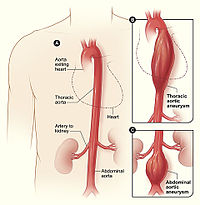
Photo from wikipedia
Purpose: Lifelong follow-up after endovascular abdominal aortic aneurysm repair (EVAR) is recommended due to a continued risk of complications, especially if the first postoperative imaging shows abnormal findings. We studied… Click to show full abstract
Purpose: Lifelong follow-up after endovascular abdominal aortic aneurysm repair (EVAR) is recommended due to a continued risk of complications, especially if the first postoperative imaging shows abnormal findings. We studied the long-term outcomes in patients with abnormalities on the first postoperative computed tomography angiography (CTA) following EVAR. Materials and Methods: This is a retrospective study of all consecutive patients who underwent elective EVAR for nonruptured abdominal aortic aneurysm (AAA) between January 2007 and January 2012 in 16 Dutch hospitals with follow-up until December 2018. Patients were included if the first postoperative CTA showed one of the following abnormal findings: endoleak type I–IV, endograft kinking, infection, or limb occlusion. AAA diameter, complications, and secondary interventions during follow-up were registered. Primary endpoint was overall survival, and other endpoints were secondary interventions and intervention-free survival. Kaplan-Meier analyses were used to estimate overall and intervention-free survival. Cox regression analyses were used to identify the association of independent determinants with survival and secondary interventions. Results: A total of 502 patients had abnormal findings on the first postoperative CTA after EVAR and had a median follow-up (interquartile range IQR) of 83.0 months (59.0). The estimated overall survival rate at 1, 5, and 10 years was 84.7%, 51.0%, and 30.8%, respectively. Age [hazard ratio (HR) 1.06, 95% confidence interval (CI) 1.05 to 1.10] and American Society of Anesthesiologists (ASA) classification (ASA IV HR 3.20, 95% CI 1.99 to 5.15) were significantly associated with all-cause mortality. Overall, 167 of the 502 patients (33.3%) underwent 238 secondary interventions in total. Fifty-eight patients (12%) underwent an intervention based on a finding on the first postoperative CTA. Overall survival was 38.4% for patients with secondary interventions and 44.5% for patients without (log rank; p=0.166). The intervention-free survival rate at 1, 5, and 10 years was 82.9%, 61.3%, and 45.6%, respectively. Conclusions: Patients with abnormalities on the first postoperative CTA after elective EVAR for infrarenal AAA cannot be discharged from regular imaging follow-up due to a high risk of secondary interventions. Patients who had a secondary intervention had similar overall survival as those without secondary interventions.
Journal Title: Journal of Endovascular Therapy
Year Published: 2021
Link to full text (if available)
Share on Social Media: Sign Up to like & get
recommendations!